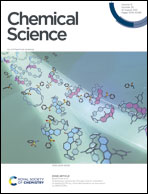Enantiopure nanohoops through racemic resolution of diketo[n]CPPs by chiral derivatization as precursors to DBP[n]CPPs†
Abstract
Strained conjugated nanohoops are attractive synthetic targets due to the bending of their π-system, which leads to intriguing optoelectronic properties, among others. By incorporating non-mirror-symmetric aromatic panels, chiral nanohoops can be obtained. We herein present a strategy to enantiopure nanohoops by racemic resolution through chiral derivatization of diketone-embedded hoops. The resulting diketo[n]CPPs (n = 6, 7) contain two stereogenic carbon atoms each and possess high fluorescence quantum yields paired with circularly polarized luminescence. These are versatile precursors to chiral dibenzo[a,e]pentalene-based nanohoops DBP[n]CPPs with antiaromatic character and ambipolar electrochemical behavior. Due to their strained structures the DBP[n]CPPs do not racemize at room temperature, which is supported by high calculated isomerization barriers. X-ray crystallographic investigations on the DBP[n]CPPs and their precursors as well as DFT calculations provide insight into the build-up of strain energy during the synthetic transformations.
![Graphical abstract: Enantiopure nanohoops through racemic resolution of diketo[n]CPPs by chiral derivatization as precursors to DBP[n]CPPs](/en/Image/Get?imageInfo.ImageType=GA&imageInfo.ImageIdentifier.ManuscriptID=D1SC02718B&imageInfo.ImageIdentifier.Year=2021)
- This article is part of the themed collections: Emerging Frontiers in Aromaticity and 2021 Chemical Science HOT Article Collection


 Please wait while we load your content...
Please wait while we load your content...